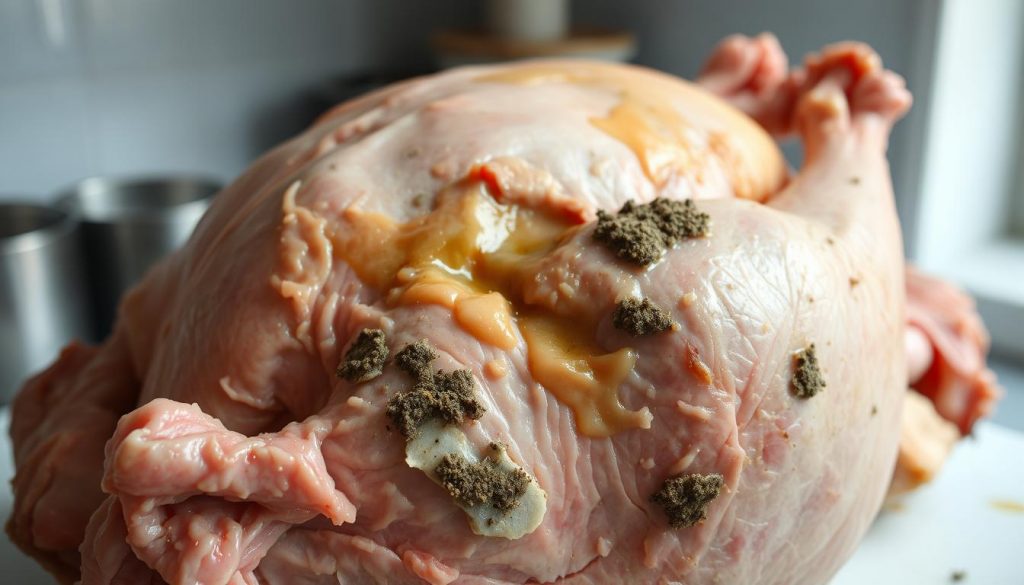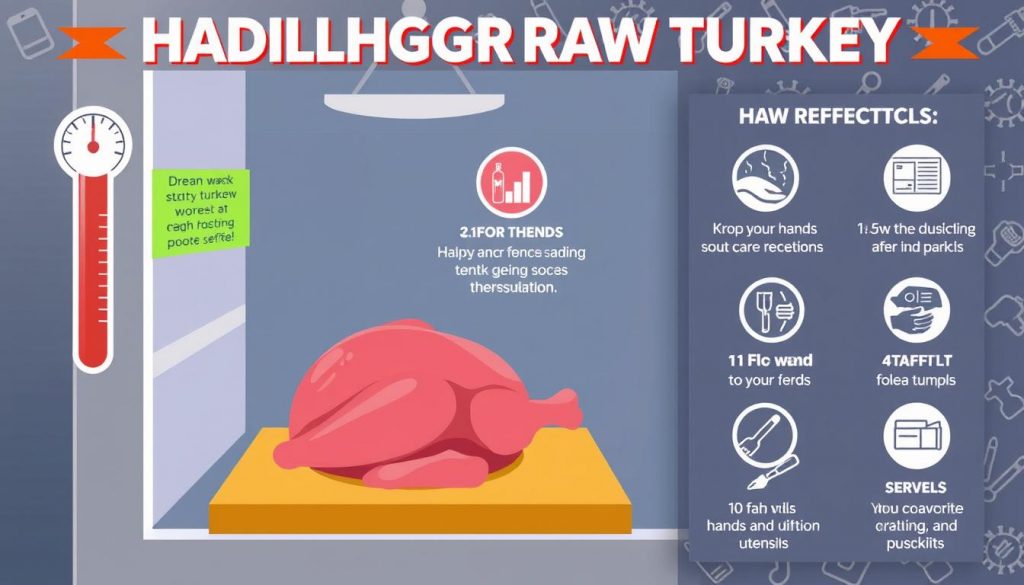Proper turkey storage is vital for safe and tasty meals. Knowing how long raw turkey lasts in the fridge ensures food safety. Let’s explore refrigeration and raw poultry to keep our dinners delicious and safe.
Turkey storage is a crucial kitchen skill. Good refrigeration can prevent foodborne illness and ensure a great meal. We’ll cover how to keep your turkey fresh from purchase to cooking time.
Key Takeaways
- Proper turkey storage is essential for food safety
- Refrigeration time affects raw poultry quality
- Understanding storage duration prevents foodborne illnesses
- Different turkey cuts have varying fridge lifespans
- Recognizing spoilage signs is crucial for safe consumption
Understanding Raw Turkey Storage Basics
Storing raw turkey correctly is vital for food safety and freshness. Let’s explore how to keep your turkey safe and tasty. Proper storage ensures your turkey remains delicious for longer.
Optimal Temperature for Turkey Storage
Keep your fridge at 40°F (4°C) or below for storing raw turkey. This cold temp slows bacterial growth, preserving freshness. Use a fridge thermometer to check and maintain this temperature.
The Importance of Proper Refrigeration
Good refrigeration prevents harmful bacteria from growing on your turkey. Store the turkey on the bottom shelf to avoid drips. This reduces the risk of contaminating other foods.
Signs of a Well-Maintained Fridge Environment
A well-kept fridge is key for turkey freshness. Look for steady temperature, no frost, and a clean interior. Make sure the door seals properly too.
- Consistent temperature readings
- No frost buildup
- Clean, odor-free interior
- Properly sealed door
Clean and organize your fridge often. This helps create the best space for storing turkey and other foods. Following these tips will keep your turkey fresh and safe to eat.
How Long Does Raw Turkey Last in the Fridge
Understanding turkey shelf life is crucial for food safety and meal planning. Proper storage of raw poultry ensures its freshness and safety for consumption.
Raw turkey can stay fresh in the fridge for 1-2 days when stored correctly. This applies to whole turkeys and cut pieces alike.
Ground turkey has a similar shelf life of 1-2 days. Proper storage is vital for maintaining freshness and safety.
| Turkey Type | Refrigerator Storage Time |
|---|---|
| Whole Raw Turkey | 1-2 days |
| Turkey Parts | 1-2 days |
| Ground Turkey | 1-2 days |
These timeframes ensure optimal quality and safety. If you can’t cook the turkey within this period, freezing is recommended.
Store the turkey in the coldest part of your fridge, around 40°F (4°C). This helps maintain its freshness for longer.
“Always prioritize food safety when handling raw poultry. When in doubt, it’s better to err on the side of caution and discard questionable turkey.”
These guidelines assume your turkey is fresh when bought and properly stored. Always check for spoilage signs before cooking, regardless of storage time.
Safe Storage Guidelines for Different Turkey Cuts
Proper turkey storage is key to food safety. This guide will help you store turkey correctly and reduce waste.
Different cuts have varying fridge lifespans. Knowing these timeframes ensures your turkey stays fresh and safe to eat.
Whole Raw Turkey Storage Time
Whole raw turkeys need special attention. Keep them in original packaging on a tray to catch drips. They stay fresh for 1-2 days in the fridge.
For longer storage, freezing is your best option. This method extends the turkey’s shelf life significantly.
Ground Turkey Storage Duration
Ground turkey has a shorter shelf life. Use it within 1-2 days of purchase. You can freeze it for up to 3-4 months.
Always check for spoilage signs before cooking. This ensures the turkey is safe to eat.
Turkey Parts and Pieces Shelf Life
Turkey pieces like breasts, thighs, or wings last 1-2 days in the fridge. Freeze them for up to 9 months if not cooking soon.
Wrap pieces tightly to prevent freezer burn. This maintains their quality during long-term storage.
| Turkey Type | Refrigerator (40°F or below) | Freezer (0°F or below) |
|---|---|---|
| Whole Raw Turkey | 1-2 days | 1 year |
| Ground Turkey | 1-2 days | 3-4 months |
| Turkey Pieces | 1-2 days | 9 months |
These guidelines help keep your turkey fresh and safe. Trust your senses when checking turkey. Discard any that smells off or looks discolored.
Signs of Turkey Spoilage to Watch For
Spotting turkey spoilage is vital for food safety. Let’s explore key signs to check if your turkey is fresh and safe to eat.
Visual Indicators of Spoilage
Check your turkey for these visual cues. Look for a slimy or sticky surface, mold growth, or discoloration.
- Slimy or sticky surface
- Mold growth
- Discoloration or dark spots
These signs clearly show that your turkey may have gone bad.
Smell and Texture Changes
Your nose can detect turkey spoilage. Fresh turkey should have little to no smell. A sour or ammonia-like odor means bacteria have started growing.

Color Variations to Be Concerned About
Color changes can show meat freshness issues. Here’s a quick guide to turkey color and its meaning:
| Color | Meaning |
|---|---|
| Pink to light brown | Fresh, safe to eat |
| Gray or green tints | Potential spoilage |
| Dark spots or patches | Bacterial growth, unsafe |
If you’re unsure about your turkey’s freshness, it’s safer to throw it out. Store turkey properly and check it often.
This helps keep meat fresh and prevents food waste.
Best Practices for Turkey Packaging
Proper packaging keeps turkey fresh and safe. Let’s explore effective methods to maintain quality and prevent cross-contamination. These tips will help you store raw turkey correctly.
Airtight storage is essential for preserving raw turkey. Use containers with tight lids or wrap the turkey in plastic wrap. Then, place it in a resealable bag for extra protection.
Store raw turkey on the bottom shelf of your fridge. This prevents juices from dripping onto other foods. Always use separate cutting boards and utensils for raw turkey.
Here’s a quick guide to effective turkey packaging:
- Remove original packaging and pat dry
- Wrap tightly in plastic wrap or aluminum foil
- Place wrapped turkey in a sealable plastic bag
- Label with the date of purchase
- Store on the bottom shelf of the fridge
| Packaging Method | Effectiveness | Shelf Life |
|---|---|---|
| Original packaging | Low | 1-2 days |
| Plastic wrap only | Moderate | 2-3 days |
| Airtight container | High | 3-4 days |
| Double-wrapped (plastic + bag) | Very High | 4-5 days |
These packaging tips will extend your turkey’s freshness. They also ensure safe food handling in your kitchen. Follow them for the best results.
Tips for Extending Raw Turkey Freshness
Keeping raw turkey fresh is vital for food safety. These tips will help extend shelf life and maintain quality. Let’s explore wrapping, temperature control, and storage container best practices.
Proper Wrapping Techniques
Wrap your turkey with plastic wrap or aluminum foil. This seals in moisture and prevents freezer burn. Press out air pockets before sealing.
For extra protection, double-wrap your turkey. You can also use freezer bags designed for long-term storage.
Temperature Control Methods
Keep your fridge at 40°F (4°C) or below. Use a thermometer to check the temperature regularly. Place raw turkey in the coldest part of your fridge.
The back of the bottom shelf is usually the coldest spot. This helps extend the shelf life of your turkey and prevent bacterial growth.
Storage Container Selection
Choose airtight, leak-proof containers to prevent cross-contamination. Glass or BPA-free plastic containers work well. Match the container size to the amount of turkey.
| Storage Method | Shelf Life | Best Practices |
|---|---|---|
| Refrigeration | 1-2 days | Keep at 40°F or below, use within 48 hours |
| Freezing | Up to 1 year | Wrap tightly, remove air, label with date |
| Vacuum Sealing | 2-3 years | Use high-quality sealer, double-check seal |
These tips will help keep your raw turkey fresh and safe. Proper food handling is crucial to prevent foodborne illnesses. Enjoy your meals worry-free by following these guidelines.
When to Freeze Instead of Refrigerate
Freezing turkey is ideal for long-term storage. It’s best when you won’t cook the turkey within a few days. This method keeps the turkey fresh and prevents spoilage.
Freezing Guidelines for Raw Turkey
Follow these steps for freezing turkey:
- Remove original packaging
- Wrap tightly in plastic wrap
- Cover with foil or freezer paper
- Label with date and contents
- Store at 0°F (-18°C) or below
Properly frozen turkey can last up to 1 year. This makes freezing perfect for long-term storage. You’ll maintain quality and have turkey ready when needed.
Thawing Methods and Safety
Safe thawing is crucial when preparing frozen turkey. Here are three reliable methods:
- Refrigerator thawing: Allow 24 hours per 4-5 pounds
- Cold water thawing: Submerge in cold water, changing every 30 minutes
- Microwave thawing: Use defrost setting, cook immediately after
Never thaw turkey at room temperature. This can cause harmful bacteria growth. Always put food safety first when handling raw poultry.
| Thawing Method | Time Required | Safety Notes |
|---|---|---|
| Refrigerator | 1-2 days | Safest method |
| Cold Water | 2-3 hours | Change water every 30 minutes |
| Microwave | 10-30 minutes | Cook immediately after thawing |
Follow these freezing and thawing guidelines for your turkey. You’ll ensure it stays fresh and safe to eat. Enjoy your perfectly preserved turkey whenever you’re ready.
Food Safety Regulations and Guidelines
Food safety is crucial, especially for raw turkey. USDA and FDA provide vital info on safe food handling. Let’s explore these rules to keep our kitchens safe and meals healthy.

USDA guidelines stress proper storage temps for raw turkey. Keep your fridge at or below 40°F (4°C) to slow bacterial growth. This step can extend turkey shelf life and prevent illness.
FDA rules highlight cleanliness in food handling. Wash hands well before and after handling raw turkey. This stops cross-contamination, a common cause of food poisoning.
| Safety Measure | USDA Guideline | FDA Regulation |
|---|---|---|
| Refrigerator Temperature | 40°F (4°C) or below | 40°F (4°C) or below |
| Hand Washing | 20 seconds with soap and water | 20 seconds with soap and water |
| Separate Cutting Boards | Recommended | Required |
| Cooking Temperature | 165°F (74°C) internal temperature | 165°F (74°C) internal temperature |
Both agencies agree on using separate cutting boards for raw meat and other foods. This stops harmful bacteria from spreading to ready-to-eat items. Safe food handling protects you and your loved ones.
Conclusion
Proper turkey storage is crucial for safe and tasty meals. Whole raw turkeys last 1-2 days in the fridge. Ground turkey should be used within 1-2 days for best quality.
Watch for signs of spoilage like odd smells or slimy texture. If you notice these, it’s time to discard the turkey. When unsure, it’s better to err on the side of caution.
Follow these guidelines to keep your turkey fresh and safe. Proper wrapping and ideal fridge temperatures are key. With these tips, you’ll enjoy delicious turkey in all your favorite recipes.




